Living room accent wall ideas – 10 new ways designers recommend to style your blank spaces
Not all living room accent wall ideas have to be about paint, as interior designers explain the best ways to add flair to your decor


Living room accent wall ideas are having to overcome a bit of a muddied past. There was a point not so long ago everyone got a bit happy with the deep purple/forest green/navy blue and painting a single wall in these bold hues was considered the height of fashion. But feature walls have come a long way since, and they are no longer just about paint or wallpaper but more about doing what they say on the tin, creating a feature in a room. And that can be in the form of artwork, photos, murals, gallery walls, storage, and yes paint and wallpaper.
As designer Lisa Le Duc says 'a feature wall has some kind of impact when you first walk into a room. You either want to go up and touch it, or stand back and admire it, or get closer to objects that surround it. It should be connected/attached/feel harmonious with the rest of room too - it shouldn’t stand too much alone in itself.'
So to prove just how much living room feature walls have come on, we asked designers to show us exactly how it's done.
10 stylish living room accent wall ideas
Before adding an accent wall to your living room, really consider what you want it to achieve and bring into your room. There is the risk that feature walls look very stark and draw focus in all the wrong ways.
'Introducing a feature wall only makes sense when you have something you want to draw focus to. Often people will use a feature wall to tentatively dabble with color, but this can give a very disjointed and slightly apologetic look.' explains Andrew Griffith, founder of A New Day 'Instead, use a block of colour or change in texture intentionally to visually adjust the shape of a space or help zone or highlight a beautiful detail. And don't forget the ceiling, that can work very well as the fifth wall to feature.'
1. Highlight your favorite features

As you are about to see, feature walls can be so much more than a single wall painted in a different color from the rest of the room. They can be way more subtle and stylish than that. You can make a feature wall of anything, with anything. Case in point with this sophisticated feature wall in which living room storage is used to create an elegant display.
'The concept of a feature wall can feel quite dated, and it's not something I would usually introduce to a scheme. That said, highlighting certain aspects or detailing of a space is an important way to draw the eye around a room or make a feature of the best bits.' explains Andrew Griffith, founder of A New Day. 'In this scheme, we made a feature of a wall of bespoke cabinetry by using a deep charcoal blue-grey. The cabinetry is used to display some of the homeowners' favorite pieces, something we highlighted with the contrast in color to the neutral walls.'
The Livingetc newsletters are your inside source for what’s shaping interiors now - and what’s next. Discover trend forecasts, smart style ideas, and curated shopping inspiration that brings design to life. Subscribe today and stay ahead of the curve.
2. Tone down the contrast

We think one of the biggest mistakes you can make with feature walls is going really bold with one wall and then just leaving the rest some magnolia bla shade. It gives the impression you just couldn't commit to taking that shade all the way around the room. So avoid this high-contrast look by paying the other walls some attention too.
'If an accent wall is used to create a focal point in your living room, the best way to play this without it dominating your room and drawing your eye solely to the contrast is to consider painting it two shades deeper than your other walls- this will help create harmony and less likely to visually shift the proportions of your room, especially if you have an awkward rectangular tunnel of a living room!' suggests Patrick O'Donnell of Farrow & Ball.
This look does work particularly well in a blue living room where you can layer up lots of different tones throughout the room as well as on the walls without it becoming too monotone. Just be sure with whatever color you go for to make sure the shades you choose have the same undertones so sit nicely next to each other. You might even just want to add some white to the darker shade so you know the shades are going to work together.
3. Turn books into a colorful feature wall

We've said it many a time, if you've got books you've got decor. Books are such a simple way to add a load of color, texture, and personality to a room, creating a display that means something to you as well as creating a feature. And there are so many looks you can create with books too – color coding, mixing vertical with horizontal, displaying the pages rather than the spines. Plus you can mix in other decorative items too like plants and pottery.
In this relatively neutral living room designed by Brooke Copp Barton the books act almost like wallpaper, adding color to a pared-back palette.
'With this bookcase wall, we wanted to use the alcove for storage, but didn’t want it to feel too closed in, so opted for floating shelves with space on either side to give the appearance of more space. And books always create a warm and entirely personal backdrop to a room.' explains Brooke.
4. Take your feature wall color on to the wood work

Again, going back to the idea that a feature wall should never just stand alone. You want to always ensure that the same color is threaded throughout the rest of the room too so whatever you have chosen to do with your feature wall feels purposeful and the main character of your living room color scheme.
'When you are thinking about a feature wall, my biggest thing that I would say is to really make sure that they don't lack confidence with it. And what I mean by that is not just painting one wall and then leaving the skirting and all the other walls just a brilliant white. It just makes the room look flat and it makes it look like you just didn't have the confidence to take that design around the whole space.' explains Tash Bradley, color expert at Lick.
'So take the color all the way down onto the skirting and then I like to encourage my clients to take the feature wall color round on all the skirting boards and into the door frames and window frames so all the room connects. And then on the other three walls and ceiling make sure you go for complimentary neutral that's softer than a bright brilliant white so the whole room harmonizes.'
5. Use a wallpaper to maximum effect
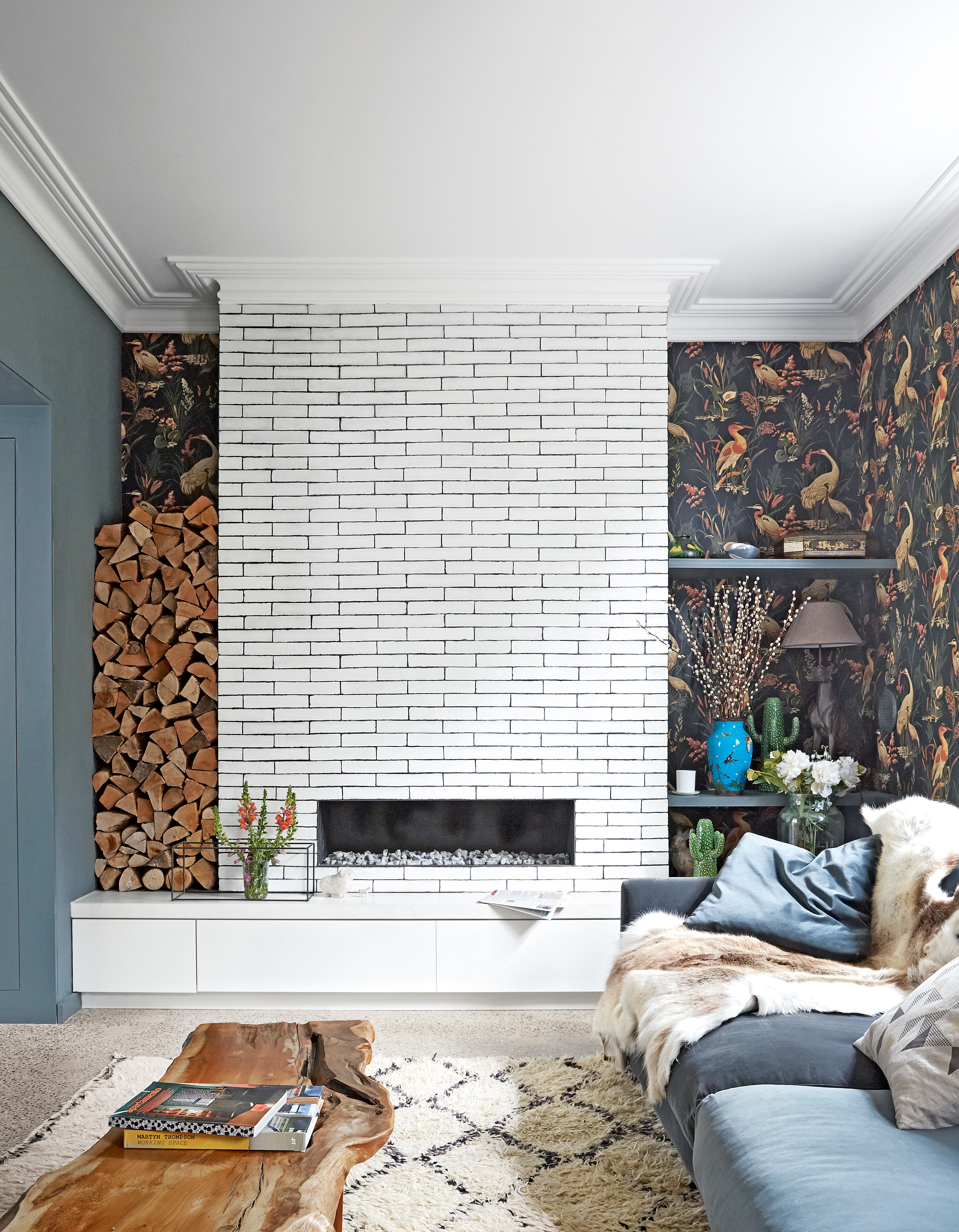
If you are after a quick and easy way to add a living room feature wall, wallpaper is the one. There's endless choice so you are always going to find something to suit your style, and it's fairly low commitment as you can change it up as your tastes change too.
Kerry McKenzie's, co-founder of Brand McKenzie, advice is to 'Start by identifying which wall you want to paper. The wall opposite the door is ideal because it’s the first thing you’ll see when you enter the room. Or if your home is blessed with architectural features like a fireplace, make a feature of the wall where it sits. If possible, try not to choose your TV wall because you don’t want to draw attention to it!'
And as we keep repeating, don't let a wallpapered wall stand alone in a sea of white wall. 'If you find a bold print you love, don’t just paper one wall and then decorate the rest of the space in a non-descript color like magnolia or cream. The secret is to stop your feature wall from looking like an afterthought. This is possible by pulling a color from the paper and painting it on the other three walls (if you are feeling brave, take it across the ceiling too). This will make your feature wall feel part of the space.' suggests Kerry.
6. Make the ceiling a feature
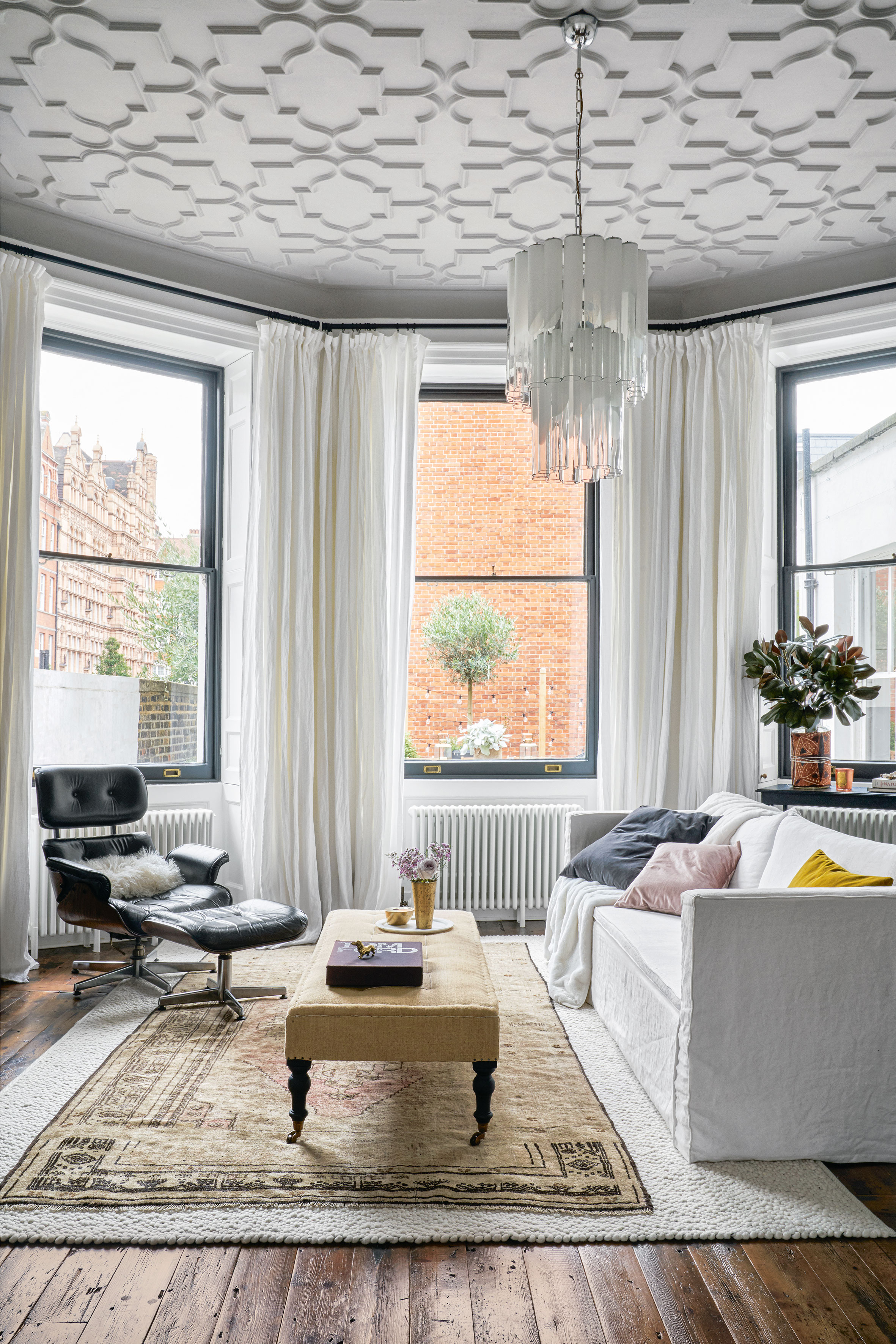
The ceiling is technically a wall, so technically it can become a feature wall. This look is ideal if you want to keep your living room feel light and bright, but add some depth that's not going to completely dominate the room.
'I love a painted ceiling.' says Tash Bradley, color expert at Lick. 'Keeping the walls a soft neutral and then wrap a dark color from the picture rail (if you have one) over the ceiling. That just adds a bit of drama, a bit of character to the room but it keeps it from feeling too overwhelmed, the space can still feel light and airy. This is a great feature wall option to go for if you spent a lot of time in your living room – you can inject some personality without going too bold.'
See how the subtle grey ceiling in this mostly white living room adds a touch of the unexpected. Plus it really highlights the beautiful architectural features rather than have them blend into the walls.
6. Experiment with bolder color palettes
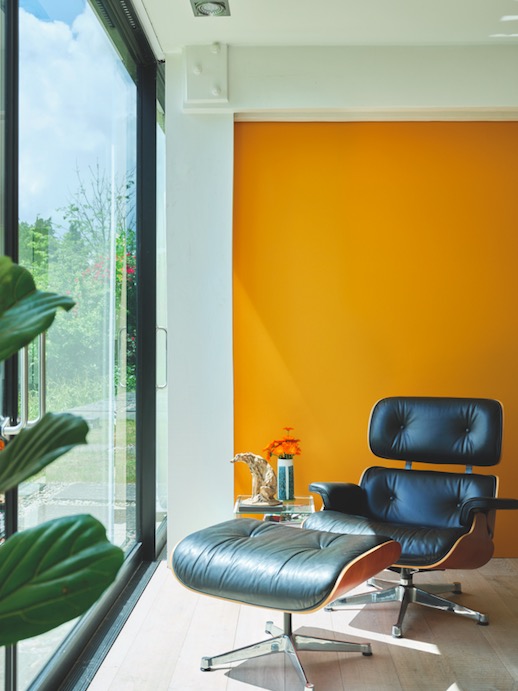
The big draw to a feature wall, and why it was so popular a few years back was that it allowed you to experiment without the commitment of a full-on room of bold color. Now we have obviously moved on from that single wall vibe, but a feature wall can still play a similar role. You can still dabble in color and test out new trends.
We are seeing a lot of love for yellows and oranges in the world of interior design trends, and it's a bold homeowner that would choose to go over every wall with yellow. Hello feature walls.
‘Paint is the simplest way to create a feature wall, it’s simple and easy. For a living room, the use of yellow can create a mellow and uplifting interior all at the same time. It transports us back to long lazy sun-drenched days in the Mediterranean and it can brighten us up on gloomy days. It works brilliantly with blues, teals, greens, and reds, and for real crisp freshness use with white.’ says Martin Waller, founder of Andrew Martin.
You just have to ensure the room looks like you have made that clear decision to paint a single wall in these sunny hues. In this space, painted in Farrow & Ball's Dutch Orange the feature wall totally works, the retro orangey tones fit the vibe, and the fact it's not taken all the way to the corners of the room makes it feel less flat and colorblock-esque.
7. Display artwork for a unique feature wall
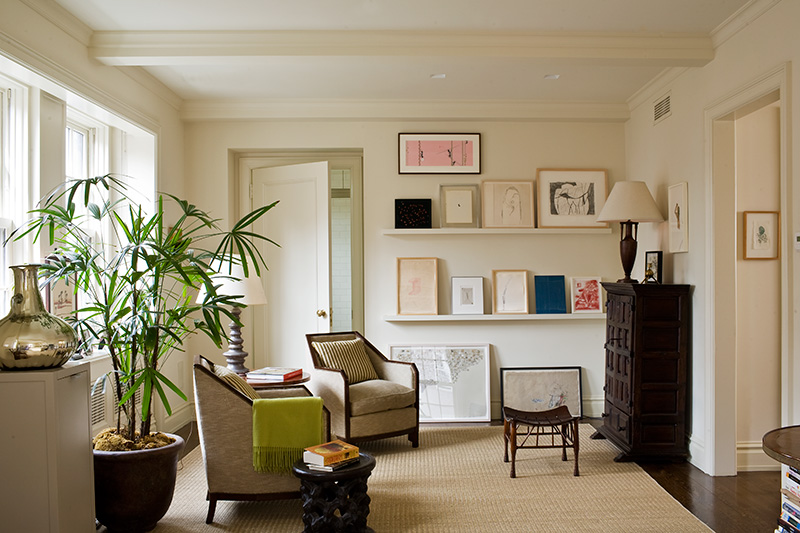
Gallery walls are a really flexible feature wall and a lovely way to bring some character and personality into a living room. Take inspiration from this living room designed by Glenn Gissler Design and hang discreet picture ledges, so rather than hang prints directly onto the wall you can easily switch out prints and change the look of your feature wall.
'The clients here are art collectors and live in Greenwich Village. This display wall allows for periodic or regular rearrangement of their extensive and ever-growing collection of modern and contemporary drawings.' explains Glenn. 'In this image there are works by Terry Winter, Richard Tuttle, Do Ho Suh, Leon Golub, Patti Smith, James Siena, Frank Moore, and others.'
See the prints on the floor and hung on the wall above too. It makes for a relaxed, effortless feel to the feature wall, and takes away any regularity in the design. Irregularity is the key to the most interesting gallery walls.
8. Use a feature wall zone a space

If your living room is part of an open-plan space, feature walls can come into their own, helping to zone different areas. Say your living room shares floor space with a kitchen or dining room, you want it to still have those cozy, cocooning vibes you'd expect from a lounge. So add that vibe by painting or covering a wall that's in the living room 'zone' with a warming shade.
This purple works really well to give the living space a real living room feel, adding depth and just a touch of drama. All the natural light helps and the fact this is actually a fabric covering rather than just paint prevents it from looking flat.
'The plain silk aubergine wall covering is from Fromental – gives warmth and intimacy to this area where light streams in from the large window. Given the space is large and open we wanted to create zones for the owners to enjoy. Areas that have functions yet don’t look contrived.' explains Laura Colonnese of Maddux Creative.
9. Create a feature with storage

Accent walls can be practical additions as well as purely aesthetic. Living room shelving creates an instant feature and unlike paint or wallpaper you can change up the look as often as you like as trends and your tastes change.
A few rules to follow when curating shelving you want to become a statement in your living room; leave negative space so the shelves don't become too cluttered, avoid creating too much symmetry and ensure to have a real mix of heights in what you choose to display.
10. Make a statement with a standout piece of artwork
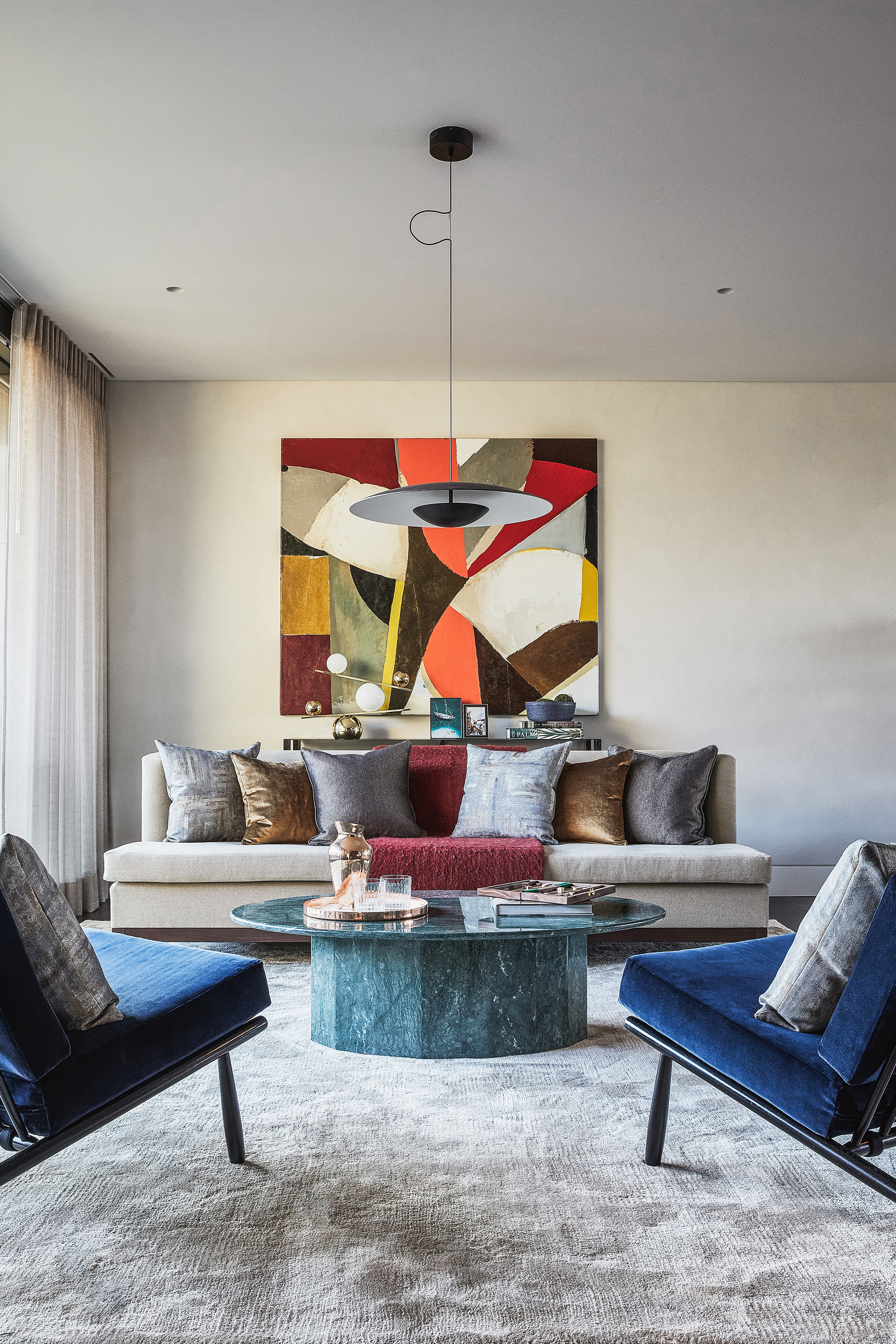
'At our Rathbone Square project for GPE plc in Fitzrovia, we created a feature wall in polished plaster applied over the final wall finish.' explains Samuel Pye, Creative Manager of Echlin.
'The newly-built room was quite large and dual aspect, so applying the finish gave the space a textural aesthetic quality that gave interest and depth to the darker areas in the center and helped draw your eye towards the light coming from the windows. The concept for the space was a contemporary reinterpretation of the Bloomsbury Group, local to the project, so for us that meant bringing in lots of colors, strong artwork, and a handcrafted quality throughout the furnishing and decoration.'
What can you use in a feature wall?
'Mirrors, artwork, wall hangings, entire storage solution of shelving, even a large scale window with a view can be the ‘feature wall’ any area in the wall that screams out to be put on show - because it serves no other functional purpose is a potential ‘feature wall’ in my book...' says Lisa Le Duc.
What wall should be a feature wall in a living room?
'Whichever wall that you make the feature wall is going to become the focal point, so in a living room this tends to either be behind the sofa or if you have a fireplace you tend to want that to be the focal point. That's the wall I recommend painting.' Tash Bradley.
'It does depend on the space.' says designer Elizabeth Hay. 'If you use your sitting room for entertaining as well as for relaxing and watching TV then you may choose to build a large bookcase along one wall to house or hide the TV and to also style nicely with books and accessories.'
What color should you paint a feature wall?
'When choosing a living room feature wall, think about how that room is used.' explains Tash Bradley, color expert at Lick Home. 'It's really important when picking colors to consider, is it a living room you spend lots of time in and you want to keep it feeling warm, calm, and lighter, or is a living room you just retreat to at the end of the day so you want it to be much cozier.'
'If you are after the latter, then going for a darker color is going to add the drama and will look better under mood lighting and soft warm lamps. If you spend more time in there during the day, opting for a lighter color tends to be the better option.'

Formerly the Digital Editor of Livingetc, Hebe is currently the Head of Interiors at sister site Homes & Gardens; she has a background in lifestyle and interior journalism and a passion for renovating small spaces. You'll usually find her attempting DIY, whether it's spray painting her whole kitchen, don't try that at home, or ever-changing the wallpaper in her entryway. She loves being able to help others make decisions when decorating their own homes. A couple of years ago she moved from renting to owning her first teeny tiny Edwardian flat in London with her whippet Willow (who yes she chose to match her interiors...) and is already on the lookout for her next project.